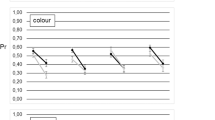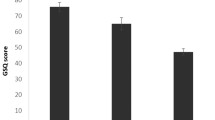Abstract
In so-called ‘mirror-touch synaesthesia’, observing touch to another person induces a subjective tactile sensation on the synaesthete’s own body. It has been suggested that this type of synaesthesia depends on increased activity in neural systems activated when observing touch to others. Here we report the first study on the prevalence of this variant of synaesthesia. Our findings indicate that this type of synaesthesia is just as common, if not more common than some of the more frequently studied varieties of synaesthesia such as grapheme-colour synaesthesia. Additionally, we examine behavioural correlates associated with the condition. In a second experiment, we show that synaesthetic experiences are not related to somatotopic cueing—a flash of light on an observed body part does not elicit the behavioural or subjective characteristics of synaesthesia. Finally, we propose a neurocognitive model to account for these characteristics and discuss the implications of our findings for general theories of synaesthesia.





Similar content being viewed by others
Notes
The predictions for synaesthetes with the anatomical sub-type are unclear because their usual synaesthetic phenomenology would contradict their own prior experiences of observing their own face in a mirror (e.g. when shaving or putting on make-up).
References
Arzy S, Thut G, Mohr C, Michel CM, Blanke O (2006) Neural basis of embodiment: distinct contributions of the temproparietal junction and the extrastriate body area. J Neurosci 26:8074–8081
Banissy MJ, Ward J (2007) Mirror-touch synaesthesia is linked with empathy. Nat Neurosci 10:815–816
Bargary G, Mitchell KJ (2008) Synaesthesia and cortical connectivity. Trends Neurosci 31:335–342
Baron-Cohen S, Wyke MA, Binnie C (1987) Hearing words and seeing colours: an experimental investigation of synaesthesia. Perception 16:761–767
Baron-Cohen S, Burt L, Smith-Laittan F, Harrison J, Bolton P (1996) Synaesthesia: prevalence and familiality. Perception 25:1073–1079
Blakemore SJ, Bristow D, Bird G, Frith C, Ward J (2005) Somatosensory activations during the observation of touch and a case of vision-touch synaesthesia. Brain 128:1571–1583
Blanke O, Ortigue S, Landis T, Seeck M (2002) Stimulating illusory own body perceptions. Nature 419:269–270
Blanke O, Landis T, Spinelli L, Seeck M (2004) Out-of-body experiences and autoscopy of neurological origin. Brain 127:243–258
Bremmer F, Schlak A, Shah NJ, Zafiris O, Kubishik M, Hoffmann K et al (2001) Polymodal motion processing in posterior parietal and premotor cortex: a human fMRI study strongly implies equivalences between humans and monkeys. Neuron 29:287–296
Brugger P (2002) Reflective mirrors: persepective-taking in autoscopic phenomena. Cogn Neuropsychiatry 7:179–194
Cohen Kadosh R, Henik A (2007) Can synaesthesia research inform cognitive science? Trends Cogn Sci 11:177–184
Cohen Kadosh R, Walsh V (2008) Synaesthesia and cortical connections: cause or correlation? Trends Neurosci 31:549–550
Cohen Kadosh R, Henik A, Walsh V (2007) Small is bright and big is dark in synaesthesia. Curr Biol 17:R834–R835
Cohen Kadosh R, Henik A, Catena A, Walsh V (2009) Induced cross-modal synesthetic experience without abnormal neuronal connections. Psychol Sci 20:258–265
Colby CL (1998) Action-orientated spatial reference frames in cortex. Neuron 20:15–24
Coslett B (1998) Evidence for a disturbance of the body schema in neglect. Brain Cogn 37:527–544
Craig AD (2002) How do you feel? Interoception: the sense of the physiological condition of the body. Nat Rev Neurosci 3:655–666
Crawford JR, Garthwaite PH (2002) Investigation of the single case in neuropsychology: confidence limits on the abnormality of test scores and test scores differences. Neuropsyhcologia 40:1196–1208
Downing PE, Jiang Y, Shuman M, Kanwisher NA (2001) Cortical area selective for visual processing of the human body. Science 293:2470–2473
Duhamel JR, Colby CL, Goldberg ME (1998) Ventral intraparietal area of the macaque: congruent visual and somatic response properties. J Neurophysiol 79:126–136
Ebisch SJH, Perucci MG, Ferretti A, Del Gratta C, Luca Romani G, Gallese V (2008) The sense of touch: embodied simulation in a visuo-tactile mirroring mechanism for observed animate or inanimate touch. J Cogn Neurosci 20:1611–1623
Fink GR, Markowitsch HJ, Reinkemeier M, Bruckbauer T, Kessler J, Heiss WD (1996) Cerebral representations of one’s own past: neural networks involved in autobiographical memory. J Neurosci 16:4275–4282
Franz EA, Ford S, Werner S (2007) Brain and cognitive processes of imitation in bimanual situations: making inference about mirror neuron systems. Brain Res 1145:138–149
Gallagher S (1995) Body schema and intentionality. In: Bermudez JL, Marcel A, Eilan N (eds) The body and the self. MIT Press, Cambridge
Giummarra MJ, Gibson SJ, Georgiou-Karistianis N, Bradshaw JL (2008) Mechanisms underlying embodiment, disembodiment and loss of embodiment. Neurosci Biobehav Rev 32:143–160
Gray JA, Chopping S, Nunn J, Parslow D, Gregory L, Williams S et al (2002) Implications of synaesthesia for functionalism. J Conscious Stud 9:5–31
Grossenbacher PG, Lovelace CT (2001) Mechanisms of synaesthesia: cognitive and physiological constraints. Trends Cogn Sci 5:36–41
Haggard P (2006) Just seeing you makes me feel better: interpersonal enhancements of touch. Soc Neurosci 1:104–110
Head H, Holmes G (1911–1912) Sensory disturbances from cerebral lesions. Brain 34:102–254
Hubbard E, Ramachandran VS (2005) Neurocognitive mechanisms of synaesthesia. Neuron 48:509–520
Iriki A, Tanaka M, Iwamura Y (1996) Coding of modified body schema during tool use by macaque postcentral neurones. NeuroReport 7:2325–2330
Johnson R, Burton P, Ro T (2006) Visually induced feelings of touch. Brain Res 1073–1074:398–406
Keyers C, Wicker B, Gazzola V, Anton JL, Fogassi L, Gallese V (2004) A touching sight: SII/PV activation during the observation and experience of touch. Neuron 42:335–346
Kircher TT, Senior C, Phillips ML, Rabe-Hesketh S, Benson PJ, Bullmore ET et al (2001) Recognizing one’s own face. Cognition 78:B1–B15
Konen CS, Kaster S (2008) Two hierarchically organized neural systems for object information in human visual cortex. Nat Neurosci 11:224–231
Macaluso E, Driver J (2003) Multimodal spatial representations in the human parietal cortex: evidence from functional neuroimaging. Adv Neurol 93:219–233
Maravita A, Iriki A (2002) Tools for the body (schema). Trends Cogn Sci 8:79–86
McCabe C, Rolls ET, Bilderbeck A, McGlone F (2008) Cognitive influences on the affective representations of touch and the sight of touch in the human brain. Soc Cogn Affect Neurosci 3:97–108
Mesulam MM, Mufson E (1982a) Insula of the old world monkey, II: afferent cortical input and comments on the claustrum. J Comp Neurol 212:23–37
Mesulam MM, Mufson E (1982b) Insula of the old world monkey, III: efferent cortical output and comments on function. J Comp Neurol 212:38–52
Olausson H, Lamarre Y, Backlund H, Morin C, Wallin BG, Starck G, Ekholm S, Strigo I, Worsley K, Valbo ǺB, Bushnell MC (2002) Unmyelinated tactile afferents signal touch and project to insular cortex. Nat Neurosci 5:900–904
Peelen MV, Downing PE (2005) Selectivity for the human body in fusiform gyrus. J Neurophysiol 93:603–608
Ramachandran VS, Hubbard E (2001) Synaesthesia—a window into perception, thought and language. J Conscious Stud 8:3–34
Rich AN, Mattingley JB (2002) Anomalous perception in synaesthesia: a cognitive neuroscience. Nat Rev Neurosci 3:43–52
Rich AN, Bradshaw JL, Mattingley JB (2005) A systematic large-scale study of synaesthesia: implications for the role of early experience in lexical-colour associations. Cognition 98:53–84
Rizzolatti G, Craighero L (2004) The mirror-neuron system. Annu Rev Neurosci 27:169–192
Rouw R, Scholte HS (2007) Increased structural connectivity in grapheme-colour synesthesia. Nat Neurosci 10:792–797
Ruby P, Decety J (2001) Effect of subjective perspective taking during simulation of action: a PET investigation of agency. Nat Neurosci 4:546–550
Saxe R, Jamal N, Powell L (2006) My body or yours? The effect of visual perspective on cortical body representations. Cereb Cortex 16:178–182
Schofield WN (1976) Do children find movements which cross the body midline difficult? Q J Exp Psychol 28:571–582
Serino A, Pizzoferrato F, Làdavas E (2008) Viewing a face (especially one’s own face) being touched enhances tactile perception on the face. Psychol Sci 19:434–438
Simner J, Holenstein E (2007) Ordinal linguistic personification as a variant of synaesthesia. J Cogn Neurosci 19:694–703
Simner J, Ward J, Lanz M, Jansari A, Noonan K, Glover L, Oakley D (2005) Non-random associations of graphemes and colour in the synaesthetic and normal populations. Cogn Neuropsychol 22:1069–1085
Simner J, Mulvenna C, Sagiv N, Tsakanikos E, Witherby S, Fraser C, Scott K, Ward J (2006) Synaesthesia: the prevalence of atypical cross-modal experiences. Perception 35:1024–1033
Sirigu A, Grafman J, Bressler K, Sunderland T (1991) Multiple representations contribute to body knowledge processing. Brain 114:629–642
Smilek D, Malcolmson KA, Carriere J, Eller M, Kwan D, Reynolds M (2007) When “3” is a jerk and “E” is king: personifying inanimate objects in synaesthesia. J Cogn Neurosci 19:981–992
Sugiura M, Watanabe J, Maeda Y, Matsue Y, Fukuda H, Kawashima R (2005) Cortical mechanisms of visual self-recognition. Neuroimage 24:143–149
Taylor JC, Wiggett AJ, Downing PE (2007) Functional MRI analysis of body and body part representations in the extrastriate and fusiform body areas. J Neurophysiol 98:1626–1633
Uddin LQ, Kaplan JT, Molnar-Szakacs I, Zaidel E, Iacoboni M (2005) Self-face recognition activates a frontoparietal “mirror” network in the right hemisphere: an event-related fMRI study. Neuroimage 25:926–935
Uddin LQ, Molnar-Szakacs I, Zaidel E, Iacoboni M (2006) rTMS to the right inferior parietal lobule disrupts self-other recognition. Soc Cogn Affect Neurosci 1:65–71
Uddin LQ, Iacoboni M, Lange C, Keenan JP (2007) The self and social cognition: the role of cortical midline structures and mirror neurons. Trends Cogn Sci 11:153–157
Ward J, Mattingley JB (2006) Synaesthesia: an overview of contemporary findings and controversies. Cortex 42:129–136
Ward J, Simner J (2003) Lexical-gustatory synaesthesia: linguistic and conceptual factors. Cognition 89:237–261
Ward J, Simner J (2005) Is synaesthesia an X-linked trait lethality in males? Perception 34:611–623
Ward J, Simner J, Auyeung V (2005) A comparison of lexical-gustatory and grapheme-colour synaesthesia. Cogn Neuropsychol 22:28–41
Ward J, Huckstep B, Tsakanikos E (2006) Sound-colour synaesthesia: to what extent does it use cross-modal mechanisms common to us all. Cortex 42:264–280
Acknowledgments
This research was supported by an ESRC studentship to MJB and an ESRC project grant to JW. The work was partly supported by a MRC project grant to VW. We would like to thank Sian Fitzpatrick, Clare Jonas, and Flor Kusnir for assistance with the research.
Author information
Authors and Affiliations
Corresponding author
Electronic supplementary material
Below is the link to the electronic supplementary material.
Rights and permissions
About this article
Cite this article
Banissy, M.J., Kadosh, R.C., Maus, G.W. et al. Prevalence, characteristics and a neurocognitive model of mirror-touch synaesthesia. Exp Brain Res 198, 261–272 (2009). https://doi.org/10.1007/s00221-009-1810-9
Received:
Accepted:
Published:
Issue Date:
DOI: https://doi.org/10.1007/s00221-009-1810-9




